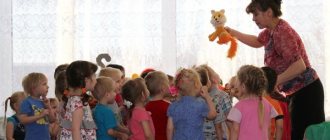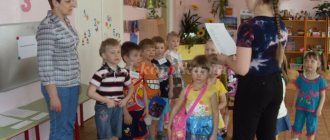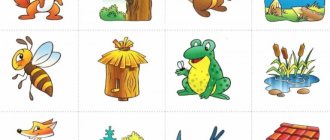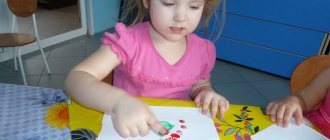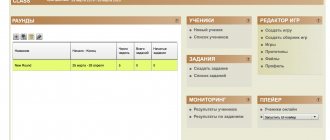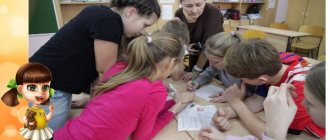Psychological and Pedagogical Center
Musilovich Tatyana Anatolevna
educational psychologist of the Early Help Department
GBOU "PPTs", Tolyatti
Adaptation of a child to new environmental conditions is a difficult and painful process. A process accompanied by a number of negative changes in the child’s body, affecting all its levels, and possibly leading to stress. Therefore, properly organized play activities aimed at forming emotional contacts “child – adult”, “child – child”, including games and exercises, will help smooth out the adaptation process of a child who has come to kindergarten for the first time. The main task of games during this period is the formation of emotional contact, children’s trust in adults, as well as uniting the children’s team. The child should see in the teacher a kind person, always ready to help (like a mother) and an interesting partner in the game. Emotional communication arises on the basis of joint actions, accompanied by a smile, affectionate intonation, and care for each child. The first games should be frontal, so that no child feels deprived of attention. The initiator of the games is always an adult. Games are selected taking into account the capabilities of the children and the location.
Advantages of the game over other means:
- allows a small child to feel “almighty”;
- helps to understand the world around us, develop self-esteem,
- develops the art of communication;
- helps manage your feelings;
- makes it possible to experience a lot of emotions.
Being one of the facets of the surrounding world, the game influences the development of memory, thinking, attention, speech, and the assimilation of social and moral norms occurs in it. At the same time, the game is the strongest emotional factor, the center of aesthetic experiences, and the environment for the formation of volitional qualities and communication skills. It is important that traditional play brings a lot of new things into the relationship between children and adults, encourages them to co-create, and has a beneficial effect on the mental and emotional spheres of both.
Requirements for games held during the adaptation period:
- they should be frontal so that no child feels deprived of attention;
- should not be too long (it is better to play with children several times a day, but little by little), but should be systematically repeated;
- the use of music, dance movements and drawing helps to relieve emotional stress in children, relax and express their feelings, switch attention, reduce excitability, and set them in a positive mood;
- the initiator of the game is an adult who shows great interest, completely controls its progress and creates a pleasant, comfortable atmosphere;
- there is no need to evaluate children, giving them the opportunity to show spontaneous and natural reactions;
- There is no need to insist on the active participation of all children. At first, it is appropriate to allow some children to simply observe what is happening. Especially if there are indecisive, timid children;
- From time to time, you can invite parents to participate in such game activities and recommend these games for repetition at home, as well as organize games at home on the topic of the child’s stay in kindergarten.
Games to build group cohesion
- "Let's get acquainted!"
Children and their teacher stand in a circle. The presenter holds the ball (for this game it is better to use an inflatable ball, since it is light and usually bright and colorful). The child says his name and the name of the person to whom he throws the ball. The named child catches the ball, calls the name and the name of the next participant in the game. Usually kids play this game with pleasure, but it can be diversified: instead of a ball, pass a toy (the most beautiful one) or invite children to greet each other by name.
- “Blow up, bubble!”
Children and a teacher create a tight circle - this is a “deflated” bubble. Everyone begins to “inflate” it: tilting their heads down, they blow into their fists, stacked one below the other, like a pipe. With each “blowing”, they take a step back, as if the bubble had enlarged a little. Then everyone joins hands and walks in a circle with the words: Blow up, bubble, swell big, Stay like that, don’t burst! It turns out to be a large stretched circle. Then the presenter (first the teacher, and later one of the children) says: “Clap!” — the bubble burst. Everyone should scatter around the room (bubbles scatter).
- "Caterpillar"
Children stand one after another and hold their shoulders. In this position, they overcome the following obstacles: get up and get off a chair, crawl under tables, go around a “wide lake,” make their way through a “dense forest,” hide from “wild animals.”
- "The Bears"
The leader (at first it can be a toy, then a child) catches up with the children scattering around the room. Those touched by the leader join hands and form a “chain”. The next “bears” are caught in a “chain”.
Sand games
Playing with sand reveals a child's natural activity. Children's first contacts with each other occur in the sandbox, which is why it is natural to use the sandbox when conducting correctional, developmental and educational activities. Sand is an excellent psychoprophylactic agent. The idea of sand therapy was proposed by the Swiss psychologist and philosopher C. G. Jung. Watching children play in the sandbox, we see how sand has a positive effect on emotional well-being, being an excellent tool for the development and self-realization of a child. At the stage of child adaptation, we use educational games aimed at developing tactile-kinesthetic sensitivity and fine motor skills. These simple exercises are accessible to children and help stabilize their emotional state, which is extremely important in the first days of a child’s stay in a preschool institution. The sandbox can be of any shape, but for correctional activities, preference is given to a square or round one: this shape improves the processes of personality integration on a subconscious level. The inner surface should be painted blue or dark blue - the bottom of the sandbox symbolizes water, and the sides symbolize the sky. There are certain requirements for sand: it must be clean, sifted (preferably calcined). In addition to spatulas, molds, scoops, a collection of small toys and objects should be collected.
1. Our handprints: the surface of the sand is smooth; sand is wet. The child and the teacher take turns making handprints, either with the inside or the outside. You need to lightly press your hand into the sand and listen to your feelings. The sand is cool or warm, dry or wet, when we move our hands along the sand, we feel small grains of sand.
2. Fist prints, knuckle prints:
The task is to find similarities with familiar objects (flower, sun, hedgehog).
3. Slide your palms along the surface of the sand - zigzag and circular movements:
The task is to show how a car drives, a snake crawls, a carousel. Along with playing with sand, you can carry out play activities with water. The value of these exercises is that, along with the development of tactile-kinesthetic sensitivity and fine motor skills, the child talks about his feelings, develops speech, voluntary attention, and memory. The formation of such personality traits as initiative, independence, and the ability to solve problems in the game takes place.
Games to build rapport with your child
- “Give me a pen!”
The teacher approaches the child and extends his hand: Let's say hello. Give me a pen!
In order not to frighten the baby, you should not be too assertive: do not come too close, pronounce the words of address to the child in a low, calm voice. To ensure correct communication, squat down or sit in a highchair - it is better for the adult and child to be at the same level and able to look each other in the face.
- "Hello! Bye!"
The teacher approaches the child and waves his hand to say hello. -Hello! Hello! Then invites the child to respond to the greeting. -Let's say hello. Wave your hand! Hello! When saying goodbye, the game is repeated - the teacher waves his hand. -Bye! Bye! Then he invites the baby to say goodbye.
-Wave goodbye. Bye! This greeting and farewell ritual should be repeated regularly at the beginning and end of the lesson. Gradually, the child will begin to show more initiative and learn to greet the teacher when meeting and leaving on his own. This game is useful because it teaches the rules of behavior between people.
- "Claw-scratch"
The teacher reads a poem and portrays a kitten: A white kitten has soft paws (strokes the other with one hand). But on each paw there are scratchy claws (he squeezes and unclenches his fingers)! Then he invites the child to pretend to be a kitten. After the child learns to pretend to be a kitten, you can offer a game in pairs: the teacher first strokes the child’s hand, then pretends that he wants to scratch it with “claws” (at this moment the child can quickly remove his hands). Then the teacher and the child change roles: the child first strokes the teacher’s hand, then “releases his claws” and tries to scratch lightly.
Games to relieve emotional and muscle tension
- "Maple leaves"
The teacher turns on calm music and hands out maple leaves to each child. The following words are said: Imagine that you are maple leaves. Autumn came, the wind tore the leaves from the trees and they began to spin in the air. Show how the leaves dance in the wind. Children, pretending to fly leaves, spin to the music. The leaves are falling, the leaves are falling (they spin around, pretending to be leaves), the yellow leaves are flying (they throw the leaves up). They rustle and rustle underfoot (they walk on the leaves), the garden will soon become bare (they lie on the floor and listen to music).
- "Train"
The teacher suggests playing “train”: “I am a locomotive, and you are carriages.” Children stand in a column one after another, holding onto the clothes of the person in front. “Let’s go,” says the adult, and everyone begins to move, saying: “Choo-chu-chu.” The teacher drives the train in one direction, then in the other, then slows down, stops and says: “Stop.” This game helps to practice basic movements - running and walking .
- “Catch-up” (carried out with 2-3 children)
The teacher encourages the children to run away from the doll, hide behind a screen, the doll catches up with them, searches for them, is glad that it found it, hugs them: “Here are my kids.” Option: the game is played with a bear.
- “Drawing different shapes”
The teacher sits with the child at the table or on the floor. Draws a circle on paper. Then he gives the child a pencil and moves his hand with the pencil along the paper, trying to draw a circle. She tells him when she’s finished: “What a good picture it turned out to be.” In the same way, he helps the child draw other shapes, draw zigzag lines and repeats each time: “What a good picture it turned out to be.” Then he invites the child to use the pencil independently. Each time the teacher starts the game, he takes a pencil of a different color - this will help the child learn to distinguish colors. Games like these help develop creative skills.
- "Bunny"
Children, holding hands, walk in a circle with the teacher. One child – the “bunny” – sits in a circle on a chair (“sleeping”). The teacher sings a song: Bunny, bunny, what's wrong with you? You're sitting there completely sick. You don't want to play. Dance with us. Bunny, bunny, dance and find another. After these words, the children stop and clap their hands. “Bunny” gets up and chooses a child, calling him by name, and he himself stands in a circle. The game repeats itself.
Physical exercises and games, which can be done several times a day, will help smooth out the adaptation period. You should also create conditions for independent exercise: offer children gurneys, cars, and balls.
The main means of work are a variety of games with speech accompaniment: round dances, marches, songs, rhymes, “ladushki” and “catch-up”. They quickly involve children in their rhythm, unite children, and set a positive emotional mood. In such games, even shy, introverted children gradually overcome their internal barrier and make contact.
Bibliography:
- Boguslavskaya Z.M., Smirnova E.O. “Educational games for children of primary preschool age. – M., 1991.
- Kalinina R. “The child went to kindergarten. To the problem of children’s adaptation to living conditions in a preschool institution // Preschool education, 1998, No. 4.
- Leontyev A.N. "Activity. Consciousness. Personality." – M., 1997.
- Lyalina I.V. "Children's adaptation upon entering kindergarten." – Volgograd: Teacher, 2001
- Ronzhina A.S. “Psychologist classes with children 2-4 years old during the period of adaptation to a preschool institution. - M.: Knigolyub, 2003.
- Chernetskaya L.V. "Psychological games and training in kindergarten." – Rostov-on-Don., 2005.
- Sertakova N.M. “Game as a means of social adaptation of preschool children: A manual for teachers of preschool educational institutions. – St. Petersburg: Publishing House “CHILDHOOD-PRESS” LLC, 2009
Games during the adaptation period of children in the first junior group.
Educator: “Guys, our friends are lost. The little pig lost Arina. Where is she?"
The children point to Arina.
“And the cockerel lost Vika.
Where is Vika? The children point to Vika.
So, with the help of toys, the teacher finds all the children
.
6. "I see…"
The teacher and children sit on chairs in a circle.
Educator: “Guys, I see Vladik. And who does Vladik see?”
Vladik names the child he is looking at. This is how all the children take turns calling the one they are looking at.
7. "Who's next to me"
Children stand in a circle with the teacher.
Educator: “Valeria and Sasha are standing next to me. I'll take their hands"
. Children take turns calling those who are standing next to them and take each other's hands.
8. "The ball rolled"
Attributes: ball
The teacher and children sit in a circle on the floor. The teacher rolls the ball to one of the children with the words
: “The ball rolled
(towards Bogdan)
.”
Bogdan catches the ball and rolls it to one of the children with the words
: “The ball rolled
(child’s name)
.”
9. "I will go"
The teacher and the children stand in a circle.
Teacher: “I’ll go to Yana”
.
Suitable for the child. “Yana, who will you go to?”
Yana calls the child’s name and approaches him. And so on.
10. "We say hello"
Attributes: mitten doll
Children stand in a circle.
The teacher walks in a circle with the doll and shakes hands with everyone. Then the children themselves come up to the doll and greet it. Children can also take turns walking in a circle and shaking hands with everyone.
11. "Mama cat"
Attributes: cat mask
Children are “kittens”
, walk freely around
the group room
.
The teacher - “cat” (you can wear a mask)
says the words:
My kittens walk, run, play.
Where are you kittens going to run?
I can't catch up with you at all.
Run quickly under my paws.
Let's play hide and seek.
“Kittens” run to the “cat” and hide under the “paws”. Not a single “kitten” (child)
should not be left behind.
12. "Ship"
Attributes: mattress, tambourine
On the palace (this is “water”
) the teacher lays out the mattress - this is
a “boat”
.
The children all need to fit on the “boat”
.
If the mattress is large, they sit; if it is small, they stand. The teacher hits the tambourine, the children “jump into the water”
and
“swim”
(walk, run around the palace, and with the next hit of the tambourine everyone climbs onto the
“boat”
.
13. "Hosts and Guests"
Attributes: one hoop per pair of children
, cat toy.
There are hula hoop houses on the floor. In every "house"
the child owner stands up.
(the one the cat chose)
.
The teacher invites each “host”
to invite a guest
(from those who were left without a house)
.
To do this, you need to say the child’s name, go up to him, take him by the hand and bring him to your home
.
Then the children change roles.
Ball games as an effective means of adapting children 2–3 years old to kindergarten conditions
Bibliographic description:
Karavaeva, T.V. Ball games as an effective means of adaptation of children 2–3 years old to the conditions of kindergarten / T.V. Karavaeva. — Text: immediate // Current issues of modern pedagogy: materials of the XII International. scientific conf. (Kazan, June 2020). — Kazan: Young scientist, 2020. — pp. 5-7. — URL: https://moluch.ru/conf/ped/archive/336/15081/ (access date: 10.10.2020).
The adaptation period is a serious test for a child of primary preschool age: from a familiar family environment he finds himself in conditions that are new to him. Solving issues related to maintaining the mental and physical health of children during the period of adaptation to kindergarten is one of the primary tasks facing kindergarten staff and parents.
What is adaptation? Adaptation is the body’s adaptation to changing external conditions, and for a child, kindergarten is undoubtedly a new, still unknown space, with a new environment and new relationships. Adaptation is an active process that leads either to positive (adaptability, i.e. the totality of all useful changes in the body and psyche) results, or negative (stress). At the same time, two main criteria for successful adaptation are identified: internal comfort (emotional satisfaction) and external adequacy of behavior (the ability to easily and accurately fulfill the requirements of the environment).
A physical education instructor, like other teachers, must create comfortable conditions in his classes for the successful adaptation of children to a preschool institution. If a child’s adaptation is successful, he rarely gets sick and, therefore, attends kindergarten. Over the course of twelve years of working with young children, I have tried different methods to ensure that children are interested in physical education classes, are cheerful and sociable. The most effective were games and exercises with the ball.
Ball games occupy a special place among outdoor games. The ball is a ball, an ideal cosmic shape, the most perfect geometric figure, having neither beginning nor end. No body of any other form has a larger surface of contact with the palm, which gives a complete sense of form. It is not without reason that one of the outstanding German pedagogues and philosophers of the 19th century, Friedrich Froebel, considered the ball one of the great gifts of pedagogy and called it “an ideal means for exercise.” The ball sends optimal information to all analyzers. The joint work of the motor, vestibular, visual and skin (tactile) analyzers, which are activated when performing exercises with a ball, enhances the effect of the exercises. Modern balls often also have different odors, allowing you to use your sense of smell along with the listed analyzers, which makes the activity more attractive and desirable.
Froebel, noting the versatile impact of the ball on the psychophysical development of a child, emphasizes its role in the development of coordination of movements, the hand, and, consequently, in activating the work of the brain. He believed that almost everything a child needs for his comprehensive development is given to him by the ball. Particularly important are games in which the child’s actions with a ball are accompanied by words and songs appropriate to the moment and mood.
In the system of physical education developed by P. F. Lesgaft, ball games also occupy an important place. While playing, a child performs various manipulations with the ball: aiming, hitting, throwing, throwing, combining movements with claps, various turns, etc., which contributes to the development of the eye and motor coordination functions. According to A. Lowen, hitting a ball improves mood, relieves aggression, helps get rid of muscle tension, and causes pleasure. Pleasure, in his opinion, is freedom of body movement from muscle armor, muscle tension.
The ball is a surprisingly interesting toy. Perhaps, people have not yet come up with anything similar - so simple and at the same time interesting. The ball is perceived by the child as something alive. He is sensitive and responsive to movement, can be obedient and mischievous, he is bright, round and very cute. You can play ball before you even learn to walk. [3] With its help, the baby can overcome his fear of an unfamiliar place and people, as a result of which the adaptation process will be easier.
This topic corresponds to the Federal State Educational Standard for Preschool Education, as it is aimed at solving the problem of protecting and strengthening the physical and mental health of children, including their emotional well-being, therefore, it is relevant for a preschool institution.
Together with an educational psychologist and educators, we conducted research on this topic. The purpose of our work was to study the influence of ball games on the process of children’s adaptation to preschool educational institutions. Problems that were solved during the research process:
- To study the problems of adaptation of preschoolers and their emotional state.
- To analyze the pedagogical conditions for the physical development of ball games that help relieve emotional stress during the adaptation period.
- To prove the impact of ball games on the process of children’s adaptation to preschool educational institutions based on theoretical and practical research of the issue.
The study took place during the first months of stay of children of two groups (control and experimental) in a preschool educational institution. Analysis of the results and research were carried out in collaboration with an educational psychologist, teachers and parents of these kindergarten groups.
Observation was used as the main methods to identify features of emotional development and assess the emotional state of the pupil. The following health-saving technologies were used in the work: psychological and pedagogical, educational, organizational and pedagogical. Visual, verbal and practical methods were used. At the preschool educational institution, a subject-spatial developmental environment was organized for physical development and psycho-emotional comfort.
The study took place in two stages.
The first stage was to determine the psychological and pedagogical parameters for determining the readiness of a child to enter a preschool institution.
The second stage of the study is the child’s entry into the group - his first month in kindergarten.
Two areas of teacher work were identified:
Direction 1: direct educational activities in physical education, in which the ball was used periodically, in accordance with the work program of the preschool educational institution; parents were given standard recommendations for adaptation.
2nd direction: physical education classes, in which ball games were always used; free activity of children in the gym, where there are balls of different sizes, soft modules, and a dry pool; The recommendations for parents included advice on what games to play with their child to relieve emotional stress.
Particular attention was paid to elementary games with the ball: putting it in a basket, rolling from an inclined bench and into the distance, throwing, sorting by color or shape.
From the theoretical analysis carried out, organizational pedagogical conditions that promote playing with the ball and their influence on adaptation to kindergarten were identified.
These conditions include:
- Subject-rich spatial development environment. Using different types of balls.
- The observer's position in the first days of the child's presence in the gym.
- Inclusion of parents in direct educational activities during the adaptation period.
A study has shown that playing with a ball helps children cope with emotional stress. Since a child of primary preschool age is limited in ways to relieve stress, not only games, but also exercises and games with a ball can come to his aid. Ball games not only contribute to physical development, but also relieve emotional stress, develop motor skills, attention, and memory.
The ball can be used to reinforce concepts: shape, color, size. Adaptation of younger preschoolers was more successful in the experimental group, where preliminary work was carried out with parents, and the physical education instructor and teachers conducted games and exercises with the ball with the children.
We can conclude that playing with a ball is a means of successful adaptation of preschool children to preschool educational institutions, and this is a necessary condition for the full development of the child. Having received positive results from the study, we introduced ball games into the adaptation period, which for the third year now have contributed to a successful, easier adaptation period.
Literature:
- Belkina L.V. Adaptation of young children to the conditions of a preschool educational institution: A practical guide. — M.: Voronezh. "Teacher", 2006 — 236 p.
- Ermakova I. A. Ball games for the little ones. - M.: Litera, 2009. — 30s.
- Ovchinnikova T. S. Games, activities and exercises with balls, on balls, in balls. Training, correction, prevention. / Ovchinnikova T. S., Baryaeva L. B., Chernaya O. V. - M.: Karo, 2010. - 248s.
- Pechora K.L., Pantyukhina G.V., Golubeva L.G. Young children in preschool institutions. – M.: VLADOS, 2003. — 172 p.
Key terms
(automatically generated)
: ball, kindergarten, game, physical education, emotional stress, preschool, adaptation period, junior preschool age, children's adaptation process, physical development.


